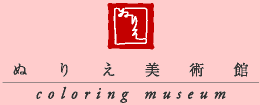« オープニングレセプション | メイン | THE ELEMENTALYさんの「おけいこおこと」 »
共同通信のニュース配信(英文)
kyoudou News on the web
◆FEATURE: Japanese coloring pages attracts new fans in New York
NEW YORK, Oct. 9 KYODO
Artist Kiichi Tsutaya's ''nurie,'' or coloring pages, beloved by postwar Japanese children, are deceptively simple and instantly arresting -- a little girl with bright eyes, a round face and chubby legs, dressed in a cute Western dress or a traditional Japanese costume, peering out at you impishly in black-and-white outline.
For the first time, Tsutaya's nurie series, considered an important influence in Japanese ''kawaii,'' or cute, pop culture, is being exhibited in New York a year after his death at age 91. Like most Japanese exports here, it was met with an enthusiastic reception.
''I want to color them in,'' Isabelle Clark, 11, said eagerly at the recent opening of ''Nurie -- The Japanese Picture Coloring Exhibition'' at the Onishi Gallery in New York's Chelsea neighborhood.
Her friends Remy Moorhead and Mariko Sredojev, both 11, agreed.
''They look fun and they're cuter than American coloring books,'' Mariko remarked, while Remy found American coloring books ''plain'' and liked that Tsutaya's nurie were hand-drawn.
Masa Kaneko, 57, Tsutaya's niece and owner of the Nurie Museum in Tokyo, said many Japanese were so poor after the war that often ''they just looked at it in the stores.''
Friends would pool their money to share one nurie set, which cost about 5 yen in the 1940s, she said.
During its heyday in the 1950s, sales of Tsutaya's nurie, sold in packets of five to eight sheets with a colorful image on the front, averaged 1 million units a month, with a high of 1.6 million.
However, the rise in popularity of TV sets at home in Japan in the 1960s led to the decline of nurie, Kaneko said.
''When you listen to the radio, you can write or draw at the same time,'' the museum owner explained. ''But when you watch TV -- the TV is very interesting, and you can't watch and do something else.''
Tsutaya said his nurie, particularly their distinctive eyes, were influenced by Western figures such as French dolls, Shirley Temple, actress Clara Bow and American cartoon idol Betty Boop.
The girls in his nurie often had wavy hair, Western dress and lounged on Western furniture, reflecting the American influence on Japanese culture after the war.
Yet the artist's drawings all adhered to a distinctively Japanese aesthetic, through the delicate brushwork due to his training in Japanese painting, the way the girl's heads are cocked slightly to the side or the depiction of girls dressed in kimono for traditional festivals such as ''Hinamatsuri,'' the Doll's Festival.
The drawings, slightly larger than a postcard, also featured a short descriptive caption and the artist's signature.
Guests at the opening reception acknowledged the ''cuteness'' of the drawings, but also said they were impressed by Tsutaya's artistry and detail.
''It's really unusual when you walk in and all of the faces on one wall are kind of in the same position,'' said children's illustrator Liz Eck. ''It's really hard to capture a really simple child's stance like he does, the sweetness and the delicateness.''
Raffaele Abbate, an entrepreneur from Italy, said he had never encountered an artist that ''specifically does children's artwork.''
''The child is alive within the Japanese and that's something fantastic because it continues to bring creativity out of them,'' Abbate commented, adding that he felt Tsutaya's techniques should be taught in American schools.
Kaneko, who opened the Nurie Museum in 2002, plans to bring the nurie exhibition, which features about 200 works, to Germany, France and possibly back to New York within the next three years.
''I'm very happy that people in New York enjoyed and recognize that in Japan there are such beautiful coloring pictures,'' she said.
During trips abroad to Europe and America, Kaneko developed an interest in the history and culture of coloring internationally. She is well-versed in the history of coloring pictures, from its roots in Paris as a way to entertain and calm children during train rides as rail travel was popularized, and its incorporation into Japanese education during the Meiji Era.
The former Shiseido Co. employee has collected about 2,000 of her uncle's nurie through donations, as well as those done by other artists, and coloring pictures from 22 countries around the world.
Having published a book about nurie culture in Japanese, Kaneko is now working on a second book about the psychology behind coloring for publication in English.
==Kyodo
投稿者:Webmaster |投稿日:06/10/09 (月)
トラックバック
このエントリーのトラックバックURL:
/981
